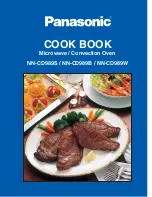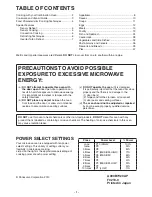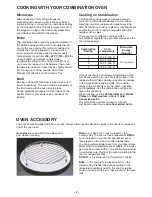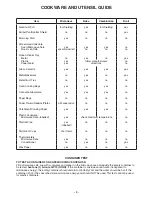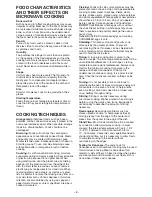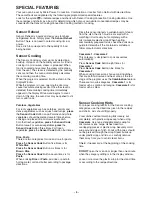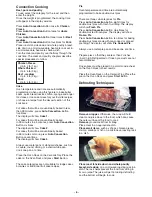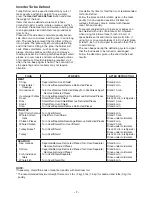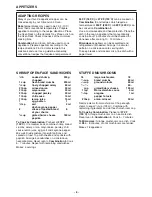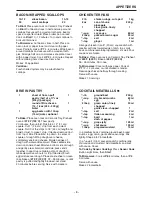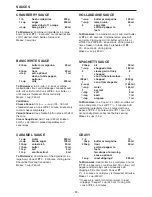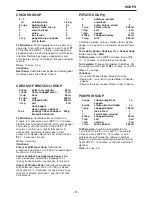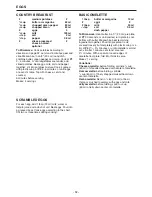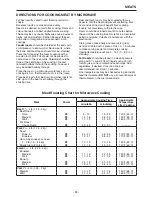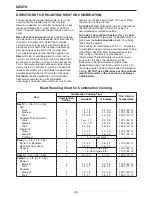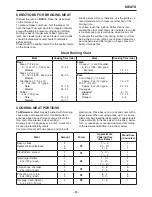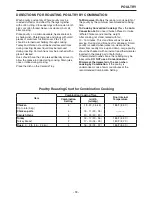
- 4 -
FOOD CHARACTERISTICS
AND THEIR EFFECTS ON
MICROWAVE COOKING
Bone and Fat
Both bone and fat affect cooking. Bones may cause
irregular cooking. Meat next to the tips of bones may
be overcooked while meat positioned under a large
bone, such as a ham bone, may be undercooked.
Large amounts of fat absorb microwave energy and
the meat next to these areas may be overcooked.
Density
Porous, airy foods such as breads, cakes or rolls
take less time to cook than heavy, dense foods such
as potatoes and roasts.
Quantity
Two potatoes take longer to cook than one potato.
As the quantity of the food decreases so does the
cooking time. Overcooking will cause the moisture
content in the food to decrease and a fire could
result. Never leave microwave unattended while in
use.
Shape
Uniform sizes heat more evenly. The thin end of a
drumstick will be cooked more quickly than the
meaty end. To compensate for irregular shapes,
place thin parts toward the centre of the dish and
thick pieces toward the edge.
Size
Small or thin pieces cook more quickly than thick
pieces.
Starting Temperature
Foods that are room temperature take less time to
cook than if they are at refrigerator temperature or
frozen.
COOKING TECHNIQUES
Arrangement:
Individual foods, such as baked
potatoes, will be cooked more evenly if placed in the
oven equal distances apart. When possible, arrange
foods in a circular pattern. Foods should not be
overlapped.
Browning:
Foods will not have the same brown
appearance as conventionally cooked foods. Meats
and poultry may be coated with browning sauce,
Worcestershire sauce, barbecue sauce or shake-on
browning sauce. To use, combine browning sauce
with melted butter or margarine, brush on before
cooking.
Covering:
As with conventional cooking, moisture
evaporates during microwave cooking. Casserole lids
or plastic wrap are used for a tighter seal. When
using plastic wrap, vent the plastic wrap by folding
back part of the plastic wrap from the edge of the
dish to allow steam to escape. Loosen or remove
plastic wrap as recipe directs for stand time. When
removing plastic wrap covers, as well as any glass
lids, be careful to remove them facing away from you
to avoid steam burns. Various degrees of moisture
retention are also obtained by using wax paper or
paper towels. However, unless specified, a recipe is
cooked uncovered.
Piercing:
Foods with skins or membranes must be
pierced, scored or have a strip of skin peeled before
cooking to allow steam to escape. Pierce clams,
oysters, chicken livers, chicken wing, whole potatoes
and whole vegetables. Whole apples or new potatoes
should have a 1-inch (2.5 cm) strip of skin peeled
before cooking. Score sausages and frankfurters.
DO NOT
Cook/Reheat whole eggs with or without
the shell. Steam built up in whole eggs may cause
them to explode, and possibly damage the oven or
cause injury.
Reheating SLICED hard-boiled eggs and cooking
SCRAMBLED eggs is safe.
Shielding:
Thin areas of meat and poultry cook
more quickly than meaty portions. To prevent
overcooking, these thin areas can be shielded with
strips of aluminum foil. Wooden toothpicks may be
used to hold the foil in place.
Timing:
A range in cooking time is given in the
charts or recipe. The time range compensates for the
uncontrollable differences in food shapes, starting
temperature and regional preferences. Always cook
food for the minimum cooking time given in the
recipe and check for doneness. If the food is
undercooked, continue cooking. It is easier to add
time. Once the food is overcooked, nothing can be
done.
Turning:
It is not possible to stir some foods to
redistribute the heat. At times microwave energy will
concentrate in one area of a food. To help ensure
even cooking, some foods need to be turned over
once, halfway through cooking.
Stirring:
Stirring is usually necessary during
microwave cooking. We have noted when stirring is
helpful, using the words once, twice, frequently or
occasionally to describe the amount of stirring
necessary.
Rearranging:
Rearrange small items such as
chicken pieces, shrimp, or hamburger patties by
moving pieces from the edge to the center and
pieces from the center to the edge of the dish.
Stand Time:
Most foods will continue to be cooked
by conduction after microwave cooking. In meat
cookery, the internal temperature will rise 5 - 15˚F
(3 - 8˚C) if allowed to stand, tented with foil, for
10 - 15 minutes. Casseroles and vegetables need a
shorter stand time, but it is necessary to allow foods
to complete cooking in the center without
overcooking on the edges.
Testing for Doneness:
The same tests for
doneness used in conventional cooking may be used
for microwave cooking. Meat is done when fork-
tender or splits at fibers. Chicken is done when juices
are clear yellow and drumstick moves freely. Fish is
done when it flakes and is opaque.

